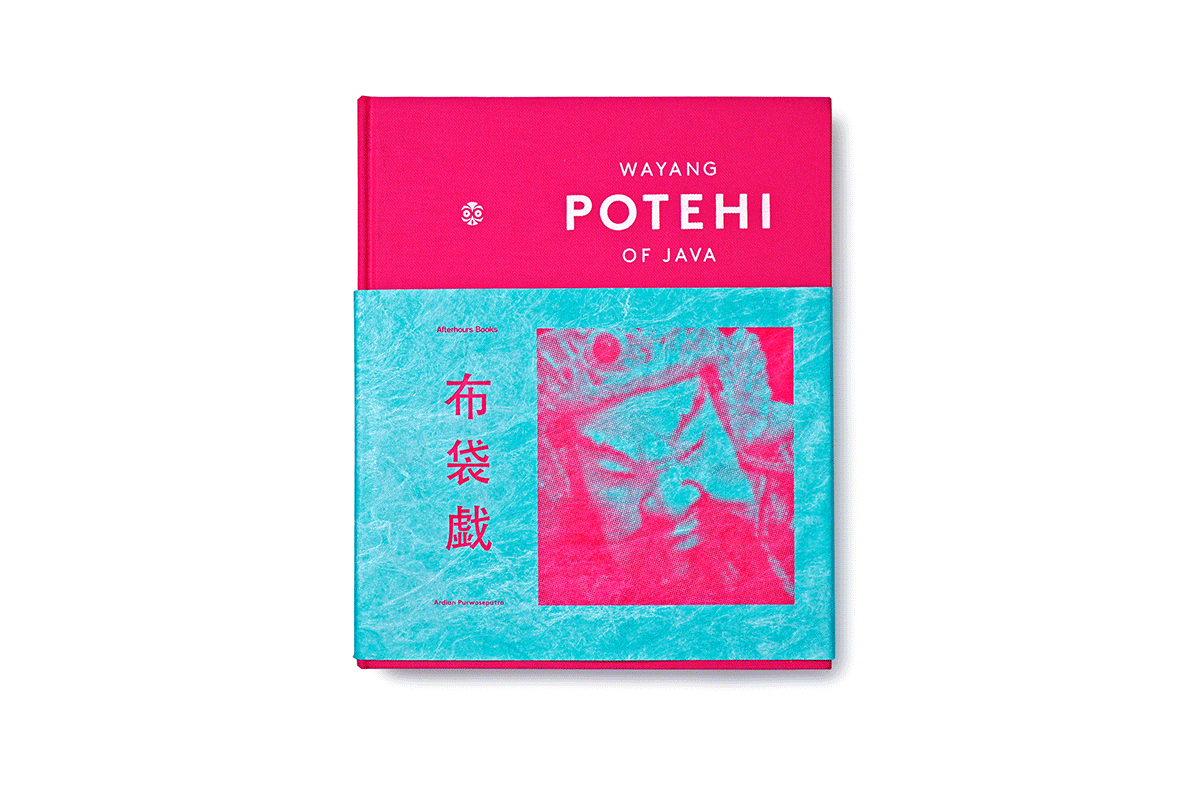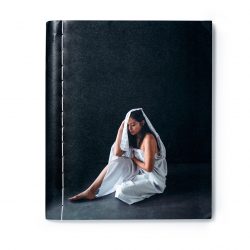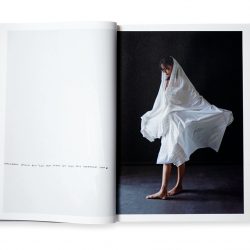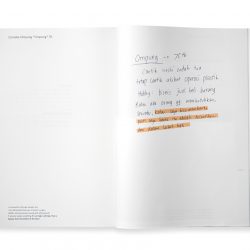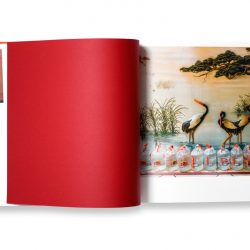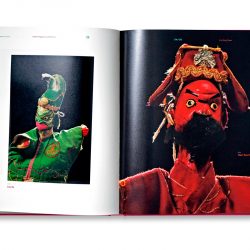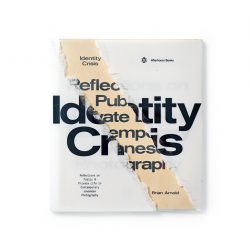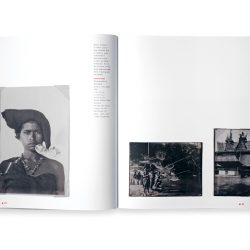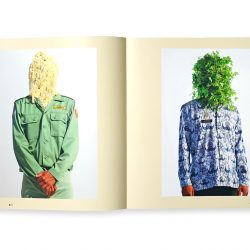LANS BRAHMANTYO, FOUNDER/PUBLISHER OF AFTERHOURS BOOKS HAS BEEN STRIVING TO MAKE PROGRESSIVE CHANGES THROUGH ART AND CULTURE
In the post-internet era where people are accustomed to the tailored search results of the world wide web, we have to admit one thing; a lot of people simply don’t buy books anymore. Yet in Indonesia, a publishing house of art books is still thriving in this turbulent time. Established in 1996 by graphic designer and photographer Lans Brahmantyo, Afterhours Books initially began as a graphic design studio, producing designs for the advertising industry and corporate clients. As Indonesia entered an economic boom where more Indonesians became interested in art as an investment vehicle, together with the fact that Brahmantyo himself came to realize the dissipation of print media in the capitalist world, Afterhours Books altered their course to instead become a publishing house of large-format art and fine photography volumes. Producing primarily in English for international readership, the publishing house showcases both international and local artists (such as Walter Spies, Affandi, Theo Meier and Arie Smit). Still continuing to remain graphic design-oriented, they have become the only Indonesian publisher to date to receive a Benny, the universally recognized symbol for excellence in the printing industry for their Walter Spies Collectors Suite.
Providing book selections to art4d himself, Brahmantyo suggested several books orbiting around the Indonesian cultural context, as the aim of Afterhours Books is to present the best of Indonesian visual arts to the world. Starting off with ‘here*now,’ a Chinesebound book documenting Vanessa van Houten’s sessions where she photographed and interviewed over fifty Indonesians aged between 20 and 80 with occupations ranging from the conventional to the more obscure. During the photoshoots, each person had to contemplate their own “inner beauty” for around 50 minutes in silence, whilst having the complete freedom to move, sit, or stand as they wanted. van Houten photographed each person twice; once in their favorite attire and once more almost bare in a white cloth made especially for this project by Chitra Subiyakto of the Indonesian fashion and textile house Sejauh Mata Memandang. Through the photographs, it becomes undeniable that there is some element of truth and beauty in abandoning clothing and revealing skin with all its scars, tattoos, birthmarks and shades. In a time where many are talking about diversity and differences, van Houten wanted to provide a glimpse into the lives of the people of Indonesia portrayed at their purest state of mind.
In ‘Home Sweet Home,’ Anton Gautama shares intimate views of where and how ethnic Chinese-Indonesian communities have lived for generations in the neighborhood he grew up and continues to live in to this day. Observing the waves of change in everyday life, his concept revolves around capturing traditions (Taoist altars, framed family photographs or wall calendars) that he feels are of social documentary importance. One can sense the liveliness of the space and the inanimate objects that have been passed on from generation to generation, maybe to the point that they are no longer in use and thus become an emblem of a person or an action of the past. The images he presents in photographs, while even though not a shadow of the homeowners can be seen within them, paradoxically act as their portraits.
Also related to the Chinese-Indonesian culture, ‘Wayang Potehi of Java,’ researched and written by Ardian Purwoseputro, addresses the iconic art form of Chinese puppet theaters in Indonesia. This hand-puppet performance art went through its own up and downs caused over centuries from political circumstances and, even so, still maintains its original format today despite the fact that the majority of the artists are now Javanese.
In addition, ‘Identity Crisis: Reflections on Public & Private Life in Contemporary Javanese Photography’ also focuses on the island of Java. The bookis the result of a three-year study of contemporary photography by Brian Arnold resulting in the highlighting of a group of artists and photographers addressing issues of personal or cultural identity, questioning or examining the forces that shape each of the individuals and the communities they represent whilst looking at the emergence and discourse of art photography in Java today. Arnold traveled to Java lecturing on photography at various institutions and universities. In doing so, he has become engaged in the developing ideas and unique perspectives of the emerging photographic trends in the Javanese art schools and markets.
According to the selection of books Brahmantyo provided, it is clear that these texts not only aim to reconstruct the immateriality of images into an archival format of printed matter, Afterhours Books also uses the medium to render the kaleidoscopic identities of Indonesia in a tangible format. Unlike how some may view the act of publishing national or cultural-specific topics as linking to patriotism or nationalism, which can either be viewed as conservative or traditional, the works portrayed don’t necessarily have to be categorized in that way as these topics actually help to depict and document the representations of the society they belong to. “A picture may be worth a thousand words, but many thousands of words are seldom sufficient to fully explain even a small facet of the complex mosaic that is the nation of Indonesia,” are the words Brahmantyo had beautifully disclosed, summing up the publishing house’s strong connections to its Indonesian roots.
In Thailand, apart from galleries publishing or funding artists’ books, there aren’t any publishing houses dedicated to this role. It would be great to be able to anticipate that some day a change in the Thai art book scene will happen.
ท่ามกลางยุค Post-Internet ที่ผู้คนหันไปบริโภคข้อมูลจาก search engine กันมากขึ้นและซื้อหนังสือกันน้อยลง ยังมีสำนักพิมพ์หนังสือศิลปะแห่งหนึ่งในอินโดนีเซียที่อยู่รอดปลอดภัยท่ามกลางวิกฤตินี้ Lans Brahmantyo กราฟิกดีไซเนอร์ / ช่างภาพ ก่อตั้ง Afterhours Books ขึ้นในปี 1966 โดยเริ่มต้นจากการเป็นกราฟิกดีไซน์สตูดิโอที่ทำงานกับวงการโฆษณาและองค์กรขนาดใหญ่ จนกระทั่งถึงยุคหนึ่งที่เศรษฐกิจอินโดนีเซียเริ่มบูม คนอินโดนีเซียเริ่มมองงานศิลปะเป็นการลงทุนมากขึ้น และ Brahmantyo ตระหนักถึงความสิ้นเปลืองของการใช้สื่อสิ่งพิมพ์ในโลกทุนนิยม เขาจึงเปลี่ยน Afterhours Books มาเป็นสำนักพิมพ์หนังสือศิลปะและภาพถ่ายขนาดใหญ่โดยตีพิมพ์ผลงานของศิลปินท้องถิ่นและนานาชาติ (เช่น Walter Spies, Affandi, Theo Meier และ Arie Smit) ในภาษาอังกฤษเพื่อขยายกลุ่มผู้อ่านให้กว้างขึ้นกว่าเดิมและด้วยงานออกแบบกราฟิกที่โดดเด่นใน Walter Spies Collectors Suite ก็ทำให้ Afterhours Books เป็นสำนักพิมพ์อินโดนีเซียเพียงสำนักพิมพ์เดียวที่ได้รับรางวัล Benny ซึ่งถือเป็นสัญลักษณ์ของการได้รับการยอมรับในระดับสากล
เป้าหมายหลักของ Afterhours Books คือการเผยแพร่ผลงานวิช่วลอาร์ตที่โดดเด่นของอินโดนีเซียออกสู่สายตานานาชาติ และนี่คงเป็นเหตุผลว่าทำไมหนังสือที่ Brahmantyo แนะนำให้กับทาง art4d จึงเกี่ยวพันกับบริบททางวัฒนธรรมของอินโดนีเซียทั้งสิ้น เริ่มจาก ‘here*now,’ โดย Vanessa van Houten ที่เข้าเล่มด้วยเทคนิคการเข้าเล่มแบบจีน หนังสือเล่มนี้เป็นบันทึกการทำงานในโปรเจ็คต์ที่ศิลปินสัมภาษณ์และบันทึกภาพชาวอินโดนีเซียอายุระหว่าง 20 ถึง 80 ปี จากหลากหลายสาขาอาชีพ (ทั้งอาชีพสามัญทั่วไปและอาชีพสีเทา) การถ่ายรูปครั้งนี้แตกต่างจากการถ่ายแบบทั่วไปเพราะศิลปินไมได้กำหนดอิริยาบถของแบบไว้ตายตัว แต่ปล่อยให้ผู้ถูกสัมภาษณ์เคลื่อนไหวได้อย่างอิสระ ไม่ว่าจะนั่ง ยืน หรือเดินไปเดินมา โดยมีข้อแม้ข้อเดียวว่าระหว่าง 50 นาทีของการถ่ายรูป เขาเหล่านั้นจะต้องคิดพิจารณาว่าอะไรคือ “คุณค่าของตัวเอง” อยู่ตลอดเวลา van Houten ถ่ายภาพพวกเขาทีละคนเป็นจำนวนสองครั้ง ภาพแรกในชุดเสื้อผ้าที่สวมใส่ปกติ ส่วนอีกภาพคือในขณะที่พวกเขาอยู่ในสภาพกึ่งเปลือยสวมใส่แค่ผ้าคลุมสีขาว (ออกแบบโดย Chitra Subiyakto ดีไซเนอร์จากแบรนด์แฟชั่นสัญชาติอินโดนีเซีย Sejauh MataMemandang) ในภาพถ่ายเหล่านี้ปฏิเสธไม่ได้ว่ามันมีองค์ประกอบของความจริงและความงามอยู่ในอากัปกิริยาที่ผู้คนปลดเปลื้องจนเห็นถึงแผลเป็น รอยสัก ปาน และสีผิวที่ไม่สม่ำเสมอ ในยุคที่ทุกคนพูดถึงความแตกต่างหลากหลาย van Houten ต้องการจะแสดงเศษเสี้ยวหนึ่งของชีวิตคนอินโดนีเซียในจุดที่สภาวะทางจิตใจของพวกเขาบริสุทธิ์ที่สุด
‘Home Sweet Home’ โดย Anton Gautama พูดถึงแง่มุมส่วนตัวเกี่ยวกับสถานที่และวิถีชีวิตที่คนอินโดนีเซียเชื้อสายจีนใช้ชีวิตจากรุ่นสู่รุ่นในพื้นที่ที่เขาเกิดและอาศัยอยู่ในปัจจุบัน พร้อมๆ กับการเฝ้าสังเกตความเปลี่ยนแปลงในชีวิตประจำวัน Gautama บันทึกภาพขนบธรรมเนียมต่างๆ ไม่ว่าจะเป็นแท่นบูชาแบบเต๋า ภาพถ่ายครอบครัว หรือปฏิทินแขวนผนัง ซึ่งเป็นวัตถุที่เขามองว่าสามารถสะท้อนความเป็นไปในสังคมได้เป็นอย่างดี เราจะสัมผัสได้ถึงความีชีวิตชีวาของพื้นที่ และความสัมพันธ์ที่ผู้คนมีต่อวัตถุที่มีความหมายทางจิตใจที่ถูกส่งต่อจากรุ่นสู่รุ่นโดยเฉพาะวัตถุที่หมดสภาพการใช้งานจนกลายมาเป็นของที่ระลึกถึงบุคคลหรือเหตุการณ์ในอดีต เราจะไม่เห็นตัวเจ้าของบ้านในภาพถ่ายเหล่านั้น แต่ความขาดนั้นก็ยังมีร่องรอยบางอย่างปรากฏให้เห็น ซึ่งทำให้ภาพเหล่านี้เป็นภาพ portrait ที่โยงไปถึงตัวตนของเจ้าของบ้านได้เป็นอย่างดี
อีกหนึ่งผลงานที่พูดถึงวัฒนธรรมจีน-อินโดนีเซียคือ ‘Wayang Potehi of Java’ โดย Ardian Purwoseputro หนังสือเล่มนี้เกี่ยวกับโรงละครหุ่นกระบอกจีนในอินโดนีเซียซึ่งถือเป็นงานศิลปกรรมประจำชาติที่ผ่านยุคผ่านสมัยมากว่าศตวรรษ (ทั้งช่วงที่รุ่งเรืองและช่วงตกต่ำด้วยผลกระทบจากสถานการณ์ทางการเมือง) และยังคงรักษาอัตลักษณ์ดั้งเดิมเอาไว้ได้ถึงปัจจุบันแม้ตอนนี้ศิลปินที่ทำการแสดงละครหุ่นเหล่านี้จะกลายมาเป็นชาวชวาแทบทั้งหมดแล้วก็ตาม
ผลงานที่ Brahmantyo แนะนำเป็นเล่มสุดท้ายคือ ‘Identity Crisis: Reflections on Public and Private Life in Contemporary Javanese Photography’ โดย Brian Arnold ซึ่งในกระแสศิลปะภาพถ่ายบนเกาะชวา หนังสือเล่มนี้เกิดมาจากงานวิจัยของ Arnold ที่ใช้เวลากว่าสามปีศึกษาเกี่ยวกับงานภาพถ่ายร่วมสมัย โดยมีกลุ่มศิลปินและช่างภาพที่ทำงานในประเด็นอัตลักษณ์ของระดับปัจเจกและทางวัฒนธรรมเป็นกรณีศึกษา ผู้เขียนตั้งคำถามและสำรวจว่าปัจจัยใดที่เป็นตัวกำหนดอัตลักษณ์ของปัจเจกและสังคมไปพร้อมๆ กับศึกษาต้นกำเนิดและไอเดียของงานภาพถ่ายร่วมสมัยในชวายุคปัจจุบัน ซึ่งด้วยความที่ Arnold เคยเดินทางไปบรรยายในมหาวิทยาลัยและสถาบันหลายแห่งในชวา มันจึงเป็นโอกาสที่ทำให้เขาได้มีส่วนร่วมในการพัฒนาความคิดและมุมมองอันเป็นเอกลักษณ์ของกระแสการถ่ายภาพที่เกิดขึ้นในโรงเรียนศิลปะในชวาและตลาดงานศิลปะท้องถิ่นไปพร้อมกัน
หนังสือหลายเล่มที่ Brahmantyo เลือกมาคงทำ.ให้เราเห็นแล้วว่ามันไม่ใช่แค่การทำให้ภาพที่จับต้องไม่ได้กลายมาเป็นสิ่งพิมพ์ที่เก็บรวบรวมได้ แต่ Afterhours Books ยังใช้ประโยชน์จากสื่อที่ว่านี้ในการควบรวมให้อัตลักษณ์อันหลากหลายของอินโดนีเซียกลายเป็นรูปธรรม ตรงกันข้ามกับความพยายามใช้หนังสือในเชิง propaganda เพื่อสร้างเรื่องเล่าระดับชาติที่หวังผลในความรักชาติหรือชาตินิยม (ที่อาจมองได้ว่าเป็นความอนุรักษนิยมหรือหัวโบราณ) พูดอีกแบบก็คือ ความพยายามของ Afterhours Books กำลังบอกเราว่าหนังสือทุกเล่มไม่จำเป็นต้องถูกเหมารวมอยู่ในหนังสือกลุ่มนั้นเสมอไป เพราะพวกเขาตั้งใจให้หนังสือได้นำเสนอและบันทึกส่วนหนึ่งของความเป็นไปในสังคมต่างหาก “ภาพหนึ่งภาพแทนความหมายนับพัน แต่คำหลายพันคำอาจจะน้อยเกินไปที่จะอธิบายแง่มุมที่เล็กที่สุดที่ประกอบขึ้นมาเป็นชาติอินโดนีเซีย” คือคำกล่าวของ Brahmantyo ที่เปิดเผยและสรุปความสัมพันธ์ที่สำนักพิมพ์ของเขามีต่อรากเหง้าความเป็นอินโดนีเซียได้อย่างครบถ้วน
กลับมาที่ประเทศไทย นอกเหนือไปจากหอศิลป์ต่างๆ ที่ตีพิมพ์และให้เงินทุนสนับสนุนการจัดทำหนังสือศิลปะแล้ว ก็ยังไม่เห็นมีสำนักพิมพ์ไหนที่เข้ามามีบทบาทรับหน้าที่ในแบบที่ Afterhours Books ทำคงเป็นเรื่องดีถ้าหากวันหนึ่งเราจะได้ตั้งตารอถึงความเปลี่ยนแปลงในทิศทางนี้จากแวดวงหนังสือศิลปะของบ้านเราบ้าง
TEXT: VIRADA BANJURTRUNGKAJORN
PHOTO COURTESY OF AFTERHOURS BOOKS
afterhoursbooks.com

